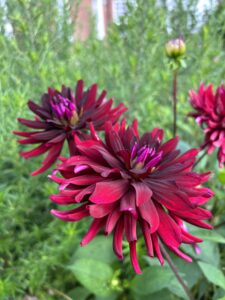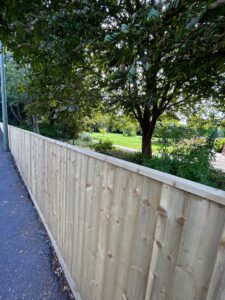Although the majority of the shrubs and trees survived the extreme winter weather, we lost some of the planting around the Dickson Poon Building which provided a perfect opportunity to change up some of the planting in the area. In Hilary term we removed some of the Miscanthus sinensis (Yakushima dwarf) and planted a mixture of grasses such as Hakonechloa, Stipa gigantica and Pennisetum. Also in the mix are some herbaceous plants such as Phlox, Kniphofia and Crocosmia, in an effort to provide a prairie style planting which is looking brilliant, with nice late flowering plants such as Helianthus ‘Lemon Queen’, Rudbeckia fulgida ‘Goldsturm’ and Verbena bonariensis; mixed with grasses such as Molinia caerulea ‘Karl Foerster’. It has even attracted the Prairie Butterfly pictured in the photo on the right.
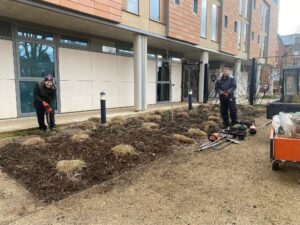
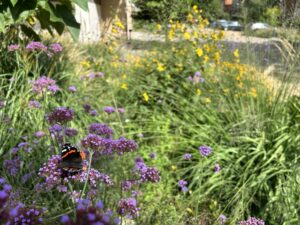
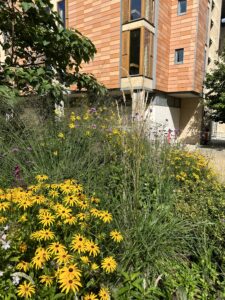
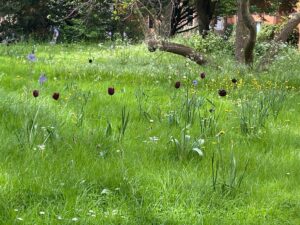
One of the areas of the gardens I think looked best this spring, was the lawn outside Rachel Tricket Building and Kenyon. We planted hundreds of muscari, anemone coronaria, fritillaria uva vulpis, tulip queen of the night, daffodils and many more spring bulbs and wildflower plugs which really brightened up the area while also benefitting pollinators.
Steven Hobson, our Deputy Head Gardener, was recently successful in applying for free packs of native tree and hedge saplings from the Woodland Trust which have been planted around the college site. These will not only make the areas more attractive, but will also benefit wildlife and help offset our CO2 emissions. The hedge sapling packs contained a mix of dog rose, hawthorn, hazel, crab apple and dogwood, and the tree sapling mix included field maple, rowan, silver birch, wild cherry, sessile oak and grey willow.
Our Magnolia × soulangeana tree on the main lawn was in full bloom this spring. The tree was originally planted for the Armistice in 1918 so it will be 105 years old this November.
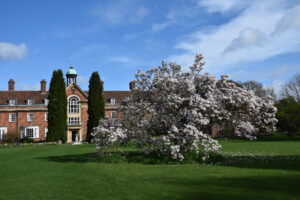
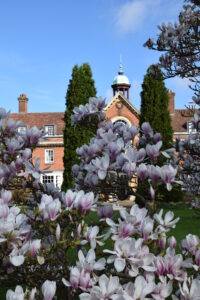
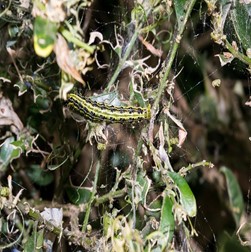
Over the course of the spring and summer I have been inundated with questions from staff, alumni and Fellows, asking what was wrong with their box plants as they were looking dead, and wondering why the college box plants looked much healthier. Some Box plants may look skeletal and unsightly, but they are in fact still alive – they have just had all their leaves munched by the hungry Asian box moth caterpillars which you can see from the pictures. The caterpillars originally came over to the UK in box plants brought en masse from Italy, to be used for landscaping ahead of the 2012 London Olympic Games, and have spread throughout the south of the UK since then. I first noticed the webbing and greenish-yellow caterpillars in 2021, however due to our commitment to organic practices, the use of pesticides is not an option. Also, pesticides are non-selective so they would also kill all other insects in the area at the time of application such as bees, ladybirds and UK native butterflies.
We have been using several organic methods to try to keep our box hedging healthy including Xenteri which contains a natural microorganism, Bacillus thuringiensis, affecting the caterpillars’ guts after they have eaten the leaves. We have also experimented with the use of volcanic rock dust, as recommended by the European Box Tree society which has proven to limit population growth within gardens (volcanic rock dust is also a great natural fertilizer).
All of these methods work well, but are expensive and time consuming to use and are not sustainable long term. So, we have taken the difficult decision to remove the college Box plants, which is disappointing as Box has been such an integral part of English gardens for centuries. We will be replacing the Box plants with English Yew (Taxus baccata), and will start replanting all the hedging on the terrace over the winter. Yew is a very robust and fairly drought tolerant plant once established – it also clips nicely into shape.
We are particularly pleased with the Dahlia ‘Nuit d’Ete’ which is performing spectacularly around the site with each flower lasting for quite a while.
Over the summer holidays, the worn fence which runs along the Banbury Road and Woodstock Road, has been replaced and now looks very smart; and should last for many years to come.
